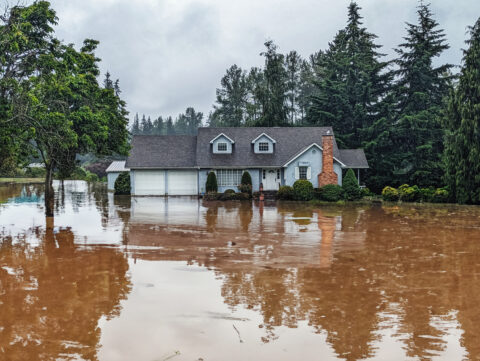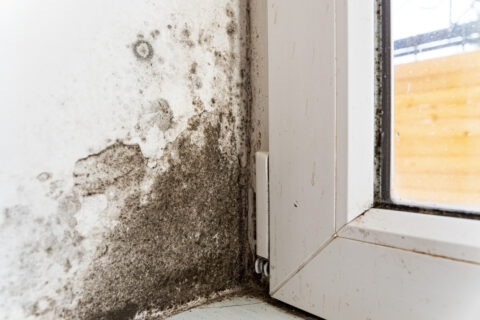
You might think that sprouting will take a while. Unfortunately, mold spores may begin to sprout immediately once they get enough water.
Buildings without Mold Problems
For buildings without mold problems, mold growth has to start from dry spores. In this case, mold growth may start within 24 to 48 hours of inundation by flood waters, according to FEMA. Since some materials can take days to dry properly after they’ve been saturated, this can make mold growth almost inevitable in these situations, unless you immediately start proper mold remediation efforts.
Buildings with Mold Problems
However, a surprising number of houses already have mold problems. A 2007 study found that about 47% of US homes have problems with dampness and/or mold. A separate study found that 45% of US office buildings also have ongoing water damage problems, including mold growth.
Common issues such as leaky pipes, repeated spills, and dripping or poorly maintained air conditioners all contribute to the presence of mold within homes and offices before the flood waters arrive. Once flood waters do arrive, homes and office buildings that already have dampness and/or mold can see explosive mold growth, far faster than in buildings without an initial mold problem.
Consequences of Mold Growth
What is the significance of mold growth in your home or business? In addition to making your building look unclean, mold can have a significant impact on your health – and the health of your building.
Health Effects of Mold Growth
Some forms of mold can be toxic, but most of the common forms growing in houses aren’t specifically toxic. However, people exposed to wet, moldy environments tend to experience a higher rate of respiratory problems. The potential problems people report after exposure to moldy environments include:
- Coughing
- Nasal congestion
- Sneezing
- Postnasal drip
- Red eyes
- Worsening of asthma symptoms
- Respiratory infections such as bronchitis or pneumonia
Not all people are impacted equally by the presence of mold. People with mold allergies, prior respiratory conditions and compromised immune systems are at the highest risk of serious complications. If you have a compromised immune system, the presence of mold could put you at risk for a life-threatening illness: fungal infection of the lungs.
Mold Destroys Your Building

Over time. The harvesting of nutrients from the wood causes its properties to change. Wood, in particular, can weaken, increasing the risk that your house may collapse after flooding.
Mold Remediation
Proper mold remediation lets you head off the risks of mold growth and preserve your home or business. Here’s how mold remediation works:
- Dry the area: Mold needs water to grow, so the first step in mold remediation is to effectively dry the area. This may include cutting off a water supply if you have ongoing leaks that contribute to the presence of water in your home or office.
- Contain mold spores: Mold spreads by air, and if you want to avoid the health and structural impacts of mold in the future, you will want to stop the spread of spores. Mold remediation experts know how to seal off an area they are working on to prevent the spread of harmful mold spores.
- Removal of materials: Some materials can’t be effectively dried in place, or they are already too saturated with mold to be saved. They will have to be removed. This includes tearing up carpet, cutting out drywall, and pulling out insulation.
- Cleaning: A thorough cleaning of mold-affected materials will stop the spread of mold and create a healthier environment in your home or office.
- Reconstruction: Wherever affected materials were removed, they will be replaced. The final result will look as attractive as if the area was never damaged by mold.
Get Mold Remediation in North Carolina, South Carolina, and Tennessee
If your home or office was impacted by flood waters, RestorePro Reconstruction can help you deal with the aftereffect of mold. We’ve been the leading restoration company in the area since 1986. We offer 24/7 emergency response services, which means we can be to your building and begin working quickly at any time of day or night. Our restoration experts use the latest techniques and technology that adhere to industry best practices, and our meticulous process includes every step of the mold remediation process.
We can also coordinate with your insurance company to smooth the claims process. We will document the original damage and all restoration steps to ensure that you can get the full compensation due under the terms of your coverage, with no reductions or delays related to poor documentation.
Learn how RestorePro Damage Restoration Experts can help you get your life back on track after a flood. Please contact us at 919-835-0676 today.
